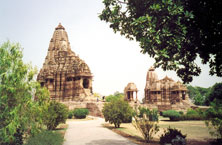Site houses temple history

About 40 Hindu temples remain in Khajuraho, Madhya Pradesh. Some are more than 1,000 years old.
Khajuraho is a small village south of Delhi, but don’t let its size fool you. There is such a long history of Hinduism in India, one that dates back to the second millennia B.C., that there is a curious supply of stupendous sites. Many are located virtually in the middle of nowhere.
My first experience with this was in Khajuraho, which is home to an amazing collection of about 40 temples built by the Chandela Rajput clan. The temples are more than 900 years old and while those that still stand are amazingly extravagant, they are merely the remnants of what was once a collection of 85 temples. The temples are not currently active, but in proximity to the main historical site is an active temple that evokes an interesting feeling of the passage of time and the perseverance of faith.
The active temple is similar in appearance to those frequented by tourists and historians and it makes one realize just how old Hinduism really is. Watching people climb the steps to worship on one side of a fence, and knowing that 1,000 years ago people were, in much the same manner and dress, walking up the steps on the other side of the fence, is a humbling experience.
During my first day in Khajuraho, fellow student Alice Ensor and myself met some young men who invited us to come to their home for lunch. They were gracious and after we had eaten lunch, they asked if Alice and myself wanted to hang out with them at their “usual spot.” We replied that we certainly did and followed them out of the village and across some farms and open meadows. Finally we came to one of the old temples from the time of the Chandela Rajput clan.
While smaller, this temple was of the same design and layout as those we had spent the day visiting inside the fenced historical site. We asked them about the seeming abandonment of this temple. They said there was a local man, whom we later met, who made sure the animals stayed out, but other than that, the temple just sat there. I was amazed this ancient temple survived in these fields outside of town, unknown to most visitors. As we entered the inner sanctum of the temple Seepu one of our new friends jumped up to a ledge and comfortably stretched out; the ease with which he did this told me it was a regular relaxing spot.
As we sat and talked inside the cool retreat of this temple, they told us of the history of the Chandelas, from whom their families were mostly descended, and pointed out different stories and symbols portrayed by the many intricacies of the temple sculpture.
This experience taught me of the central place religion holds in the lives of many Indians. Hinduism is the prevalent religion of India, with approximately 82 percent of Indians identifying themselves as Hindu.
What statistics like this failed to teach me in the classroom was the splendor and magnificence a few millennia can afford a tradition, in this case Hinduism. Hinduism is woven into every aspect of life for most Indians, and given India’s population of 1.2 billion, this is a significant number of people.
Your donation will support the student journalists of Missouri Southern State University. Your contribution will allow us to purchase equipment and cover our annual website hosting costs.















